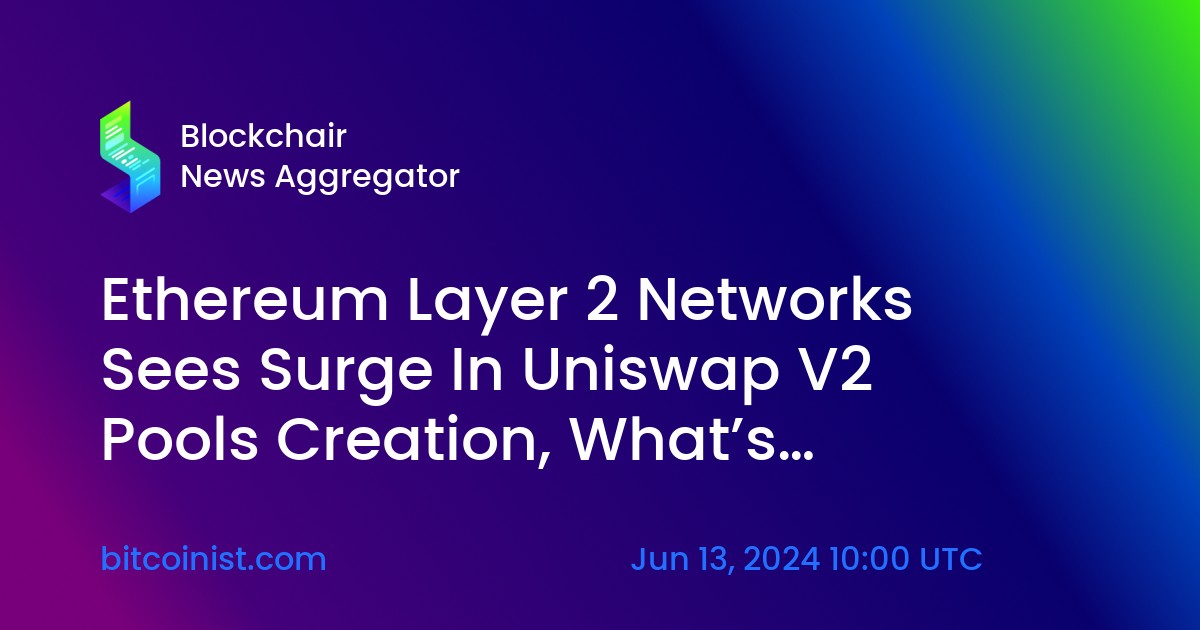Ethereum Layer 2 (L2) solutions are currently experiencing a significant surge in the deployment of Uniswap V2 pools, marking a notable development in the Decentralized Finance (DeFi) ecosystem. Uniswap V2 pools give users the ability to swap between ERC-20 tokens directly, and this token pool is called the Liquidity Pool.
The recent wave of new pools is changing the game by lowering transaction costs and improving scalability, two issues that have plagued the Ethereum mainnet for a long time.
Ethereum Layer 2 Adoption Surges
Popular market expert and crypto enthusiast, YG Crypto reported the development on the X (formerly Twitter) platform. YG Crypto noted that although Ethereum continues to be the industry leader in DeFi, things are starting to change, as layer 2 solutions are seeing an increase in the number of Uniswap V2 pools being created.
At the vanguard of this growth are Layer 2 solutions like Arbitrum, Optimism, and Polygon, which provide a more effective setting for decentralized exchanges and liquidity pools. By reducing ETH’s congestion and expensive gas costs, these platforms increase DeFi’s usability for a wider variety of users.
This widespread use of Uniswap V2 pools on these networks highlights how important Layer 2 technologies are becoming to Ethereum’s scalability and the future of DeFi.

In addition to showcasing the Ethereum network’s resilience and flexibility, it also represents growing confidence and investment in Layer 2 solutions, which will propel the subsequent wave of DeFi innovation and user acceptance.
Furthermore, YG Crypto highlighted several factors that could be driving this surge in Uniswap V2 pool deployment on the ETH layer 2 networks. The first factor pointed out by the expert is the L2 scalability. According to YG Crypto, layer 2 solutions are perfect for high-traffic DeFi applications like Uniswap since they are capable of processing a lot more transactions than Ethereum.
Another factor underscored by the expert is the lower gas fees these L2s offer in comparison to ETH mainnet. Given that the gas fees on layer 2 networks are significantly lower than that of Ethereum, users are able to engage in Uniswap pools at a cheaper cost.
Last but not least is improved user experience. Uniswap pools are flocking the Ethereum layer 2 networks since they provide a more seamless user experience and quicker transaction confirmations, which are essential in ushering in new users and keeping existing ones.
Significance Of Layer 1 And Layer 2 Blockchains
It is important to note that both layer 1 and layer 2 blockchain solutions enhance the throughput and speed of any cryptocurrency blockchain network. Layer 1 blockchains are the foundational design of a decentralized crypto network, while layer 2s are additional blockchains or collections of protocols incorporated into the layer 1 solutions.
Layer 1 blockchains utilize a shared consensus technique like proof of work (PoW) or proof of stake (PoS), to manage transaction processing and network security. Although L2s are more adaptable in terms of scaling transaction processing and network throughput, they still rely on the L1s for network and security architecture.





